Comparison of Distributed Data-Parallelization Patterns
for Big Data Analysis: A Bioinformatics Case Study
Jianwu Wang, Daniel Crawl, Ilkay Altintas
Kostas Tzoumas, Volker Markl
Technische Universität Berlin
San Diego Supercomputer Center
University of California, San Diego
La Jolla, U.S.A
{jianwu, crawl, altintas}@sdsc.edu
Berlin, Germany
{kostas.tzoumas, volker.markl}@tu-berlin.de
scalability and performance
ABSTRACT
As a distributed data-parallelization (DDP) pattern, MapReduce
has been adopted by many new big data analysis tools to achieve
good
in Cluster or Cloud
environments. This paper explores how two binary DDP patterns,
i.e., CoGroup and Match, could also be used in these tools. We re-
implemented an existing bioinformatics tool, called CloudBurst,
with three different DDP pattern combinations. We identify two
factors, namely, input data balancing and value sparseness, which
could greatly affect the performances using different DDP
patterns. Our experiments show: (i) a simple DDP pattern switch
could speed up performance by almost two times; (ii) the
identified factors can explain the differences well.
Categories and Subject Descriptors
[Computer-Communication Networks]: Distributed
C.2.4
[Software
Systems – Distributed Applications; D.2.11
Engineering]: Software Architectures – Domain-specific
architectures.
General Terms
Algorithms, Design, Experimentation, Performance, Verification
Keywords
Distributed Data-Parallelization; MapReduce; Performance
Comparison
1. INTRODUCTION
[2], e.g.,
Distributed Data-Parallelization
MapReduce [3], are reusable practices for efficient design and
execution of big data analysis and analytics applications. Such
DDP patterns combine data partition, parallel computing and
distributed computing technologies. To date, many applications in
scientific domains
such as bioinformatics, ecology and
geoinformatics utilized DDP patterns for large-scale datasets in
distributed environments. For example, the CloudBurst tool [4]
uses MapReduce to parallelize bioinformatics sequence mapping
on multiple compute nodes for large datasets.
Over
than
MapReduce have also been proposed [6][7][10] to solve different
types of big data analysis problems. Yet to the best of our
knowledge, comparisons of different DDP patterns on
Permission to make digital or hard copies of all or part of this work for
personal or classroom use is granted without fee provided that copies are
not made or distributed for profit or commercial advantage and that
copies bear this notice and the full citation on the first page. To copy
otherwise, or republish, to post on servers or to redistribute to lists,
requires prior specific permission and/or a fee.
DataCloud’13, Nov. 17, 2013, Denver, CO, U.S.A.
last couple of years, DDP patterns other
(DDP) patterns
the
performance when applied to the same tool and the main factors
affecting such performance have not been studied. This paper
explores different DDP options for such a scenario where
different DDP patters can be used alternatively and switched for
efficiency purposes. Our experiments show that performances of
different DDP vary greatly for different inputs and run time
parameter configurations. As a result of our study, we identify two
main factors that affect the DDP pattern performance. We expect
these results to help DDP researchers in finding the best DDP
pattern and configurations for their own tools.
The contributions of this paper include: (i) Using an existing
bioinformatics tool as an example, we demonstrate multiple
feasible DDP options for many sequence mapping bioinformatics
tools; (ii) We identify two key factors affecting the performances
of different DDP options; (iii) We conduct experiments to
demonstrate the feasibility of the identified factors and show that
switching DDP option could speed up performance by over 1.8
times.
Outline. The rest of this paper is organized as follows. In Section
2, we discuss advantages of DDP patterns and explain four DDP
patterns we use in this paper in detail. Section 3 describes how
multiple DDP patterns could be used for many sequence mapping
tools via a case study and identifies factors affecting the
performances for different DDP pattern options. In Section 4, we
describe the results of our experiments to show the performance
differences for different DDP options and the feasibility of the
identified factors in a Cluster environment. Section 5 discusses
related work. In Section 6, we discuss our conclusions and plans
for future work.
2. DDP PATTERNS
DDP patterns provide opportunities to easily build efficient big
data applications, which can execute in parallel by splitting data in
distributed computing environments. Such DDP patterns include
Map, Reduce, Match, CoGroup, and Cross (a.k.a. All-Pairs
[6][7]). Based on the functional programming paradigm, each
DDP pattern represents a higher-level programming model to
perform a certain function. Developers using these DDP patterns
only need to focus on how their specific data process problems
can be depicted in these programming models, and write
corresponding user functions.
The definitions and key properties of the DDP patterns that are
used in this paper are listed in Table 1. Map and Reduce process a
single input, while CoGroup and Match process two inputs. For
all patterns, each input data is a set of pairs. Further
formal definitions of these patterns can be found in [7].
There are an increasing number of execution engines that
implement one or more DDP patterns described in Table 1. By
taking care of underlying communications and data transfers,
�
these DDP execution engines can execute user functions in
parallel with good scalability and performance acceleration when
running on distributed resources. In addition to the well-adopted
MapReduce execution engine Hadoop1, Cloud MapReduce2 and
MapReduce-MPI3 are also available MapReduce execution
engines. The Stratosphere system supports all the DDP patterns in
Table 1 as part of their PACT programming model [7].
Meanwhile, CoGroup, Match and Cross could be transformed into
Map and Reduce to run on Hadoop. For instance, the Cascading
framework4 supports dataflow paradigm using DDP patterns such
as Each (similar to Map) and CoGroup and transforms these
patterns into MapReduce to run on Hadoop. Our bioKepler
project5 [17] also supports CoGroup, Match and Cross on Hadoop
by differentiating inputs [13].
Table 1. Definitions and key properties of the DDP patterns
used in this paper
Map
Reduce
CoGroup
Match
• Independently processes each pair.
• User function can be executed in parallel based
on input keys.
• Partitions the pairs based on their
keys.
• All pairs with the same key are processed
together in one instance of the user function.
• Executions for different keys can be done in
parallel.
• Partitions the pairs of the two input
sets based on their keys.
• For each input, all values with the same key form
one subset.
• Each user function instance gets three inputs
comprised of a key and two value subsets for the
key.
• Executions for different keys can be done in
parallel.
• If a key is only at one input set, the value subset
for this key from the other input will be empty.
• Partitions the pairs of the two input
sets based on their keys.
• Value pairs from the Cartesian product of the two
value subsets for the same key are processed
together.
• Each value pair from the product and the key will
be processed by an instance of the user function.
• Executions for different inputs can be done in
parallel.
• If a key is only at one input set, no user function
will be instantiated for this key.
3. A BIOINFORMATICS CASE STUDY:
DDP OPTION COMPARISON FOR
SEQUENCE MAPPING
In this section, we use a popular bioinformatics tool for sequence
mapping, called CloudBurst [4], to demonstrate how different
DDP pattern combinations could be used for the same tool and
compare their performances. Original CloudBurst is implemented
1 Hadoop Project: http://hadoop.apache.org, 2013
2 Cloud MapReduce: http://code.google.com/p/cloudmapreduce/, 2013
3 MapReduceMPI: http://www.sandia.gov/∼sjplimp/mapreduce.html, 2013
4 Cascading Framework: http://www.cascading.org/, 2013
5 bioKepler Project: http://www.biokepler.org/, 2013
on top of Hadoop using Map and Reduce DDP patterns. Our re-
implementations using Map, Reduce, CoGroup and Match are
built on top of Stratosphere to utilize direct support for all of these
four DDP patterns we used.
3.1 Sequence Mapping Bioinformatics Tools
Next-generation sequencing (NGS) technologies caused a huge
increase in the amount of DNA sequence data being produced [1].
The sequences from NGS devices, called reads, are usually
mapped to a reference sequence dataset in order to know whether
there are similar fragments in reference data for each read and
where the similar fragments are. The similarity threshold is
defined by a parameter called mismatches (k), which is the
maximum allowed length of differences. Many popular sequence
mapping tools employ an algorithm called seed-and-extend [12].
This algorithm first finds sub-strings called seeds with exact
matches in both the reads, or query sequences, and the reference
sequences, and then extends the seeds into longer, inexact
matches. The length of a seed is decided by parameter mismatches
(k) and another parameter called reads length (m) with formula
m/(k+1). Although following the same algorithm, these tools use
different methods for finding and extending seeds, resulting in
different features and performances.
Seed Extraction
map (key, value)
if (input is query)
emit
for every seed
emit
for non-overlapping
seed
else
Data Shuffle
...
...
Input
Input
...
Input
Seed Extension
reduce (k, list)
for each v in list
if (v is query)
ql.add(v)
else
rl.add(v)
for each q in ql
for each r in rf
extend(q,r)
Figure 1. MapReduce Implementation of CloudBurst.
CloudBurst is a parallel seed-and-extend sequence mapping tool
[4]. By adopting Map and Reduce patterns, CloudBurst has Seed
Extraction, Data Shuffle and Seed Extension phases, as depicted
in Fig. 1. The Seed Extraction phase uses the Map pattern to
process both the query and reference sequences and emits seeds in
parallel. Its output is a list of pairs where key is the
seed identifier and value contains detailed information of the seed,
including its sequence string and offset in original sequence. The
Data Shuffle phase groups seeds shared between the query and
reference sequences. The Seed Extension phase extends the
shared seeds by allowing mismatches. This phase uses the Reduce
pattern so different seeds can be processed in parallel. In this
phase, CloudBurst first splits the value list into two lists by
checking whether it is query or reference. Next, it gets all pairs of
elements from the Cartesian product of the two lists, and extends
seeds for these pairs to generate mapping results. The scalability
and performance
in distributed
environments have been described in [4]. Based on the results in
[4], we picked CloudBurst as a good case study to try different
DDP patterns and analyze their differences.
Please note that the query and reference datasets of CloudBurst
have to be distinguished throughout the phases. Since Map and
Reduce only support one input dataset, the query and reference
datasets have to be differentiated in an indirect way when using
Map and Reduce patterns. The details of this differentiation are
outside the scope of this paper.
speedup of CloudBurst
�
3.2 Using CoGroup and Match Patterns for
CloudBurst
We use the MapCoGroup and MapMatch patterns to re-implement
CloudBurst, which are shown in Fig. 2 and Fig. 3 respectively.
CoGroup and Match are natural DDPs to process two input
datasets, and they both can have two Map functions for the Seed
Extraction phase for query (Qry in the figures) and reference (Ref
in the figures) data separately. For the Seed Extension phase, the
differences of each pattern compared
the MapReduce
implementation of CloudBurst are as follows:
•
CoGroup: Each CoGroup user function instance gets a
reference list and a query list for the same key (lr and lq in
Fig. 2), so it needs one less loop compared to the
MapReduce implementation of CloudBurst, i.e., it does not
need the first loop in Fig. 1.
to
• Match: Because each Match user function instance directly
gets one query value and one reference value for the same
key (q and r in Fig. 3), it does not need any of the loops in
the MapReduce implementation of CloudBurst.
Ref
...
Ref
Qry
...
Qry
Ref
...
Ref
Qry
...
Qry
Seed Extraction
map (key, value)
emit
for every seed
map (key, value)
emit
for non-overlapping
seed
m, vr
1>
j>
1, lq
1>
2, lq
2>
...
m, lq
m>
for every seed
map (key, value)
emit
for non-overlapping
seed
Figure 3. MapMatch Implementation of CloudBurst.
Data Shuffle
...
1, vq
1>
1>
2>
z>
j>
Seed Extension
match (k, q, r)
extend(q,r)
in Stratosphere
re-implemented CloudBurst
for
We also
MapReduce pattern by following the same logic in Fig. 1. From
programming perspective, most of
the original code of
CloudBurst is reused in our new implementations for all three
DDP pattern combinations. Some changes were made to comply
with the Stratosphere APIs for the DDP patterns and input/output
formats.
As mentioned in Section 3.1, many sequence mapping tools use a
similar seed-and-extend logic with CloudBurst, so we believe the
findings can be also applied for many other sequence mapping
tools.
3.3 DDP Performance Comparison
For the abovementioned DDP options for CloudBurst, the Map
parts are almost the same. The only difference is the Map function
in MapReduce is split into two Map functions for MapCoGroup
and MapMatch. Since the Map outputs of these DDP options are
the same, the Data Shuffle phase also takes the same amount of
time. So the main difference is in the way the map output data is
read into and processed in Reduce/CoGroup/Match.
Total execution time of Reduce/CoGroup/Match includes two
main parts: user function execution time and overhead to load the
is
user function and input data. By looking into how Reduce pattern
and Match pattern work, we identify two main factors that could
affect their performances. The first factor is the difference
between the numbers of keys in the two input data, denoted as p.
The second factor
the average number of values per
query/reference key, denoted as q.
The first factor, namely p, reflects the balance of the two input
datasets. If one dataset is much larger than the other one, their key
sets will have less common keys. Then Reduce pattern will have
more user function executions with empty set for one input data,
and these executions will not generate any results. But Match will
not have user function executions for this situation. Imbalanced
input datasets will cause a lot of unnecessary Reduce function
execution. So Reduce is more suitable for balanced input datasets
and Match is more suitable for imbalanced ones.
The second factor, namely q, reflects the sparseness of the values
for each key. If each key has a lot of values, Match has to have a
separate user function instance for each possible value pairs.
While Reduce only needs one execution to process all values for
the same key. At this situation, overhead of loading the user
function and input data becomes dominant. So Reduce is more
suitable for condensed values per key and Match is more suitable
for sparse values per key.
For each user function execution, CoGroup takes less time than
Reduce since it does not need the first loop in Seed Extension
phase of Fig. 1, but takes more time than Match because it also
have unnecessary executions with empty set from one input.
Meanwhile, CoGroup’s user function execution number is the
same with Reduce’s and less than Match’s. So its total overhead is
the same with that of Reduce and less than that of Match. Overall,
CoGroup’s total execution time should be in the middle of those
of Reduce and Match.
4. EXPERIMENTS
We have done experiments by running CloudBurst using different
patterns to answer two questions: (i) Would changing the DDP
pattern to execute the same function have a big influence on the
performance? (ii) Can the two factors identified in Section 3.3
adequately explain the performance differences?
We tested our implementations of CloudBurst in Stratosphere
(version 0.2) with Reduce, CoGroup and Match in a compute
Cluster environment. Five compute nodes are used in these
experiments: one for master node and the other four for slave
nodes. Each node has two four-core Intel 2.5GHz CPUs, 32GB
memory, and runs Red Hat 5.9 Linux. Since our target is to
compare performance differences with different DDP patterns, not
to verify scalability, we only run the programs with a static
physical environment.
In CloudBurst, both values of p and q will change accordingly
when k value changes, and k value normally ranges from 0 to a
small integer. So we tested different executions of the same
program and parameters except the value of k. All experiments
below are done with 12 parallel Map/Reduce/Match/CoGroup
instances.
For all the experiments in this section, we repeat the execution for
each configuration three times and find their execution times are
similar. Thus, only their average values are listed for these
execution times.
�
4.1 Execution Performance of CloudBurst
using Different DDP Options
The first experiment is done with two real large datasets. The
query dataset is publicly available sequencing reads from the 1000
Genomes Project6 (access number: SRR001113), which has over
nine million sequences and the sequence length is 47. The
reference dataset is Monterey Bay metagenomic sequence data
from CAMERA project7, which has over 1.2 million sequences
whose lengths range from 26 to 458. In this experiment, the
Reduce/CoGroup/Match user function execution numbers range
from three thousand to 11 billion. The executions of these
different DDP patterns have the same results if their parameters
are the same, but their performances are very different as seen in
Table 2. The execution times for all three DDP combinations
increase with different speeds when k value increases. The
speedup of MapMatch over MapReduce
reaches 1.890
(=2.786/1.474) for k=0. We will interpret the performance
differences in the next sub-section.
Table 2. The execution times (unit: minute) of different DDP
implementations of CloudBurst for large query and reference
Mismatch number (k)
3
0
1
2
MapReduce
MapCoGroup
2.786
1.564
3.405
1.916
3.537
2.477
8.622
24.640
2.689
1.883
1.474
MapMatch
47.393
The second experiment is done with only a large reference
dataset. The reference dataset is the same as above and the query
dataset only include the first 5000 sequences of the query dataset
from the 1000 Genomes Project that is used in the last experiment.
In the second experiment, the Reduce/CoGroup/Match user
function execution numbers range from three thousand to seven
million except the Match number for k=0 is zero since no seeds
with the same key are found from both query and reference
dataset. From Table 3, we can see the performances of MapMatch
are always better than those of MapReduce.
Table 3. The execution times (unit: minute) of different DDP
implementations of CloudBurst for only large reference
3
Mismatch number (k)
0
1
2
MapReduce
MapCoGroup
MapMatch
1.920
1.523
1.453
2.313
1.754
1.690
2.565
1.907
1.763
2.538
1.888
1.799
Table 2 and 3 also show MapCoGroup’s execution times are
always between those of MapReduce and MapMatch. It matches
our analysis in Section 3.3. Based on the above experimental data,
we can clearly see that different DDP patterns have great impact
on the execution performance of CloudBurst. Implementations
using Match and CoGroup have much better performances when
parameter k’s value is low. The experimental data also show no
DDP pattern combination is always the best, even only for
different configurations of
tool. The execution
performance varies based on input data and parameters. These
initial experiments provide evidence that DDP pattern selection of
the same tool could be very important for its performance.
6 The 1000 Genomes Project: http://www.1000genomes.org/, 2013
7 CAMERA Project: http://camera.calit2.net/, 2013
the same
4.2 Effectiveness of Performance Factors
To explain the performance differences shown above and verify
the effectiveness of the two factors identified in Section 3.3, we
use log information get the values of p and q for each execution,
and try to find the possible relationships between these factors and
the performance differences. The data is shown in Table 4 and 5
along with speedup ratio of MapMatch to MapReduce. These
tables show the values of the two factors greatly affect which
DDP pattern has better performance. Both tables show most
speedup ratios decrease along with the decrease of p values and
the increase of q values. For k=3, it is interesting to see MapMatch
is much slower than MapReduce for large query and reference,
but a little faster for only large reference. We believe the reason is
that q value decreases more dramatically than p value increases
from the experiment with large query and reference to the
experiment with only large reference (In Table 4 and 5, for k=3, p
value difference between only large reference and large query and
reference is 16 folds, while q value difference is 166 folds).
Table 4. The relationship between execution speedup and its
factors for large query and reference
2
0
1
3
Mismatch number (k)
Key set size difference
(p) (unit: million)
167
163
116
0.28
Average value number
per key (q)
1.6E-5
1.6E-2 6.05E-1 2.73E3
Speedup ratio of Map-
Match to MapReduce
Table 5. The relationship between execution speedup and its
1.201
1.890
1.704
0.181
factors for only large reference
Mismatch number (k)
Key set size difference
(p) (unit: million)
Average value number
per key (q)
Speedup ratio of Map-
Match to MapReduce
0
1
2
3
179
189
149
4.16
0
1.8E-5
4.6E-4
1.74
1.321
1.369
1.455
1.411
The relationships between the two factors with the performance
differences shown from the above experimental data match our
analysis in Section 3.3. So it verifies our analysis and feasibility
of these factors. Please note that in these initial experiments the
changes of k causes changes of both p and q. In the future, we will
try to change one factor’s value while keeping the other’s value
the same by deliberately manipulating input datasets.
5. RELATED WORK
There have been many sequence mapping tools using DDP
patterns to process big sequence data in parallel, such as
CloudBurst, CloudAligner [8] and CloudBLAST [9]. The
differences of these tools are measured in terms of capabilities,
accuracy, performance and so on. But they are all built on top of
MapReduce pattern, and do not discuss whether other DDP
patterns could also be used for their tools.
Other DDP patterns, such as All-Pairs [6], PACT [7] in
Stratosphere, Sector/Sphere [10], are often compared with
MapReduce when they are first proposed. Some studies, such as
[6], show their applications in bioinformatics. But most of these
comparisons are done using different DDP engines, so it is hard to
�
know how different DDP patterns affect the same tool’s
performance on
the same DDP engine. In [11], several
applications were implemented and compared using different
DDP patterns, but no experimental data on their performance
differences were given.
There are also studies on performance modeling of DDP pattern.
Paper [14] and [15] estimate MapReduce performance by
mathematically modeling its phases using different sets of
parameters such as Hadoop parameters, user input profiles and
system-level parameters. Study in [16] identified five factors;
such as I/O mode and indexing that affect Hadoop’s performance.
Our work is different from the above work from a few aspects: (i)
These studies focus on system level factors, while we focus on
application level factors; (ii) These studies only study MapReduce
pattern, whereas we study performance comparison between DDP
patterns; (iii) These studies are tested on Hadoop, and our
experiments is based on Stratosphere DDP execution engine.
Further, because of these differences, we think our work is
complementary to these studies and can work together to analyze
the performance of specific DDP applications.
6. CONCLUSIONS AND FUTURE WORK
In the “big data” era, it is very popular and effective to use DDP
patterns in order to achieve scalability and parallelization. These
DDP patterns also bring challenges on which pattern or pattern
combination is the best for a certain tool. This paper demonstrates
different DDP patterns could have a great impact on the
performances of the same tool. We find that although MapReduce
can be used for wider range of applications with either one or two
input datasets, it is not always the best choice in terms of
application complexity and performance. To understand the
differences, we identified two affecting factors, namely input data
balancing and value sparseness, on their performance differences.
The feasibility of
through
experiments. We believe many tools in bioinformatics and other
domains have a similar logic with CloudBurst as they need to
match two input datasets, and therefore could also benefit from
our findings.
For future work, we plan to investigate more tools that are suitable
for multiple DDP patterns and their performances on other DDP
engines like Hadoop, which will generalize our findings. We will
also study how to utilize the identified factors to automatically
select the best DDP pattern combination from multiple available
ones.
7. ACKNOWLEDGMENTS
This work was supported by NSF ABI Award DBI-1062565 for
bioKepler. The authors would like to thank the rest of bioKepler
and Stratosphere teams for their collaboration. We also thank the
FutureGrid project for experiment environment support.
8. REFERENCES
[1] J. Shendure and H. Ji, “Next-generation DNA sequencing,”
two factors
Nature Biotechnology 26 (10) (2008) 1135–1145.
these
is verified
[2] J. Wang, D. Crawl, and I. Altintas. “A framework for
distributed data-parallel execution in the Kepler scientific
workflow system,” Procedia Computer Science 9 (2012):
1620-1629.
[3] J. Dean and S. Ghemawat, “MapReduce: Simplified data
processing on large clusters,” Communications of the ACM
51 (1) (2008) 107–113.
[4] M. Schatz, “CloudBurst: Highly sensitive read mapping with
MapReduce,” Bioinformatics 25 (11) (2009) 1363–1369.
[5] A. D. Smith, Z. Xuan, and M. Q. Zhang, “Using quality
scores and longer reads improves accuracy of Solexa read
mapping,” BMC Bioinformatics, 9, 128 (2008).
[6] C. Moretti, H. Bui, K. Hollingsworth, B. Rich, P. Flynn, D.
Thain, “All-Pairs: An abstraction for data-intensive
computing on campus Grids,” IEEE Transactions on Parallel
and Distributed Systems 21 (2010) 33–46.
[7] D. Battré, S. Ewen, F. Hueske, O. Kao, V. Markl, D.
Warneke, “Nephele/PACTs: A programming model and
execution framework for web-scale analytical processing,”
In: Proceedings of the 1st ACM symposium on Cloud
computing, SoCC ’10, ACM, New York, NY, USA, 2010,
pp. 119–130.
[8] T. Nguyen, W. Shi, and D. Ruden, “CloudAligner: A fast and
full-featured MapReduce based tool for sequence
mapping,” BMC research notes 4, no. 1 (2011): 171.
[9] A. Matsunaga, M. Tsugawa, and J. Fortes. “CloudBlast:
Combining mapreduce and virtualization on distributed
resources for bioinformatics applications,” In: Proceedings of
IEEE 4th International Conference on eScience, eScience'08,
2008, pp. 222-229. IEEE, 2008.
[10] Y. Gu and R. Grossman, “Sector and Sphere: The design and
implementation of a high performance data cloud,”
Philosophical Transactions of the Royal Society A 367
(1897) (2009) 2429–2445.
[11] A. Alexandrov, S. Ewen, M. Heimel, F. Hueske, O. Kao, V.
Markl, E. Nijkamp, and D. Warneke, “MapReduce and
PACT-comparing data parallel programming models,” In :
Proceedings of the Conference Datenbanksysteme in Büro,
Technik und Wissenschaft (BTW), GI, Bonn, Germany, pp.
25-44. 2011.
[12] H. Li and N. Homer, “A survey of sequence alignment
algorithms for next-generation sequencing.” Briefings in
bioinformatics 11.5 (2010): 473-483.
[13] M. Płóciennik, T. Żok, I. Altintas, J. Wang, D. Crawl, D.
Abramson, F. Imbeaux, B. Guillerminet, M. Lopez-Caniego,
I. C. Plasencia, W. Pych, P. Ciecieląg, B. Palak, M. Owsiak,
Y. Frauel and ITM-TF contributors, “Approaches to
Distributed Execution of Scientific Workflows in Kepler,”
accepted by Fundamenta Informaticae.
[14] H. Herodotou, “Hadoop Performance Models,” Technical
Report, CS-2011-05, Duke Computer Science, 2011,
http://www.cs.duke.edu/starfish/files/hadoop-models.pdf.
[15] X. Lin, Z. Meng, C. Xu, and M. Wang. “A practical
performance model for Hadoop MapReduce,” In:
Proceedings of Cluster Computing Workshops (CLUSTER
WORKSHOPS), 2012 IEEE International Conference on, pp.
231-239. IEEE, 2012.
[16] D. Jiang, B. C. Ooi, L. Shi and S. Wu, “The performance of
mapreduce: An in-depth study,” In: Proceedings of the
VLDB Endowment 3, no. 1-2 (2010): 472-483.
[17] I. Altintas, J. Wang, D. Crawl, W. Li, “Challenges and
approaches for distributed workflow-driven analysis of large-
scale biological data”, In: Proceedings of the Workshop on
Data analytics in the Cloud at EDBT/ICDT 2012
Conference, DanaC2012, 2012.
�
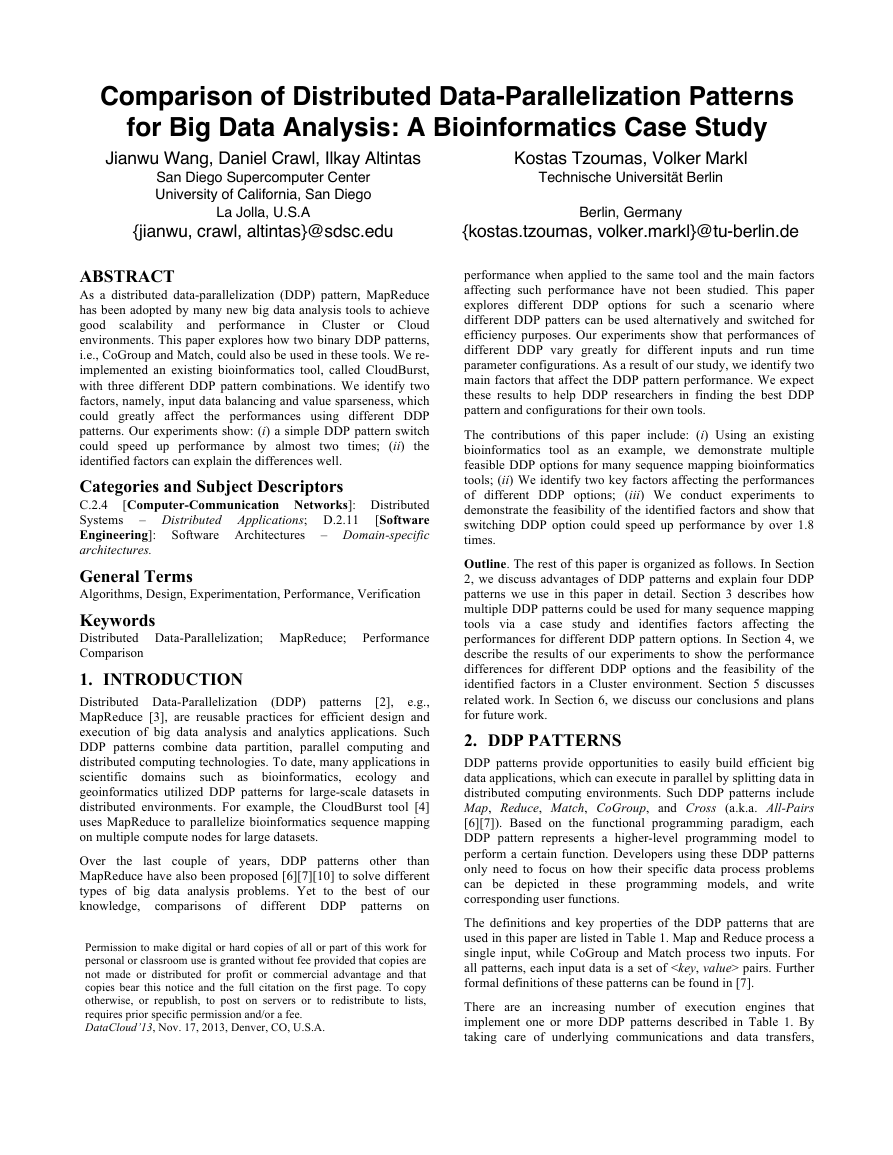
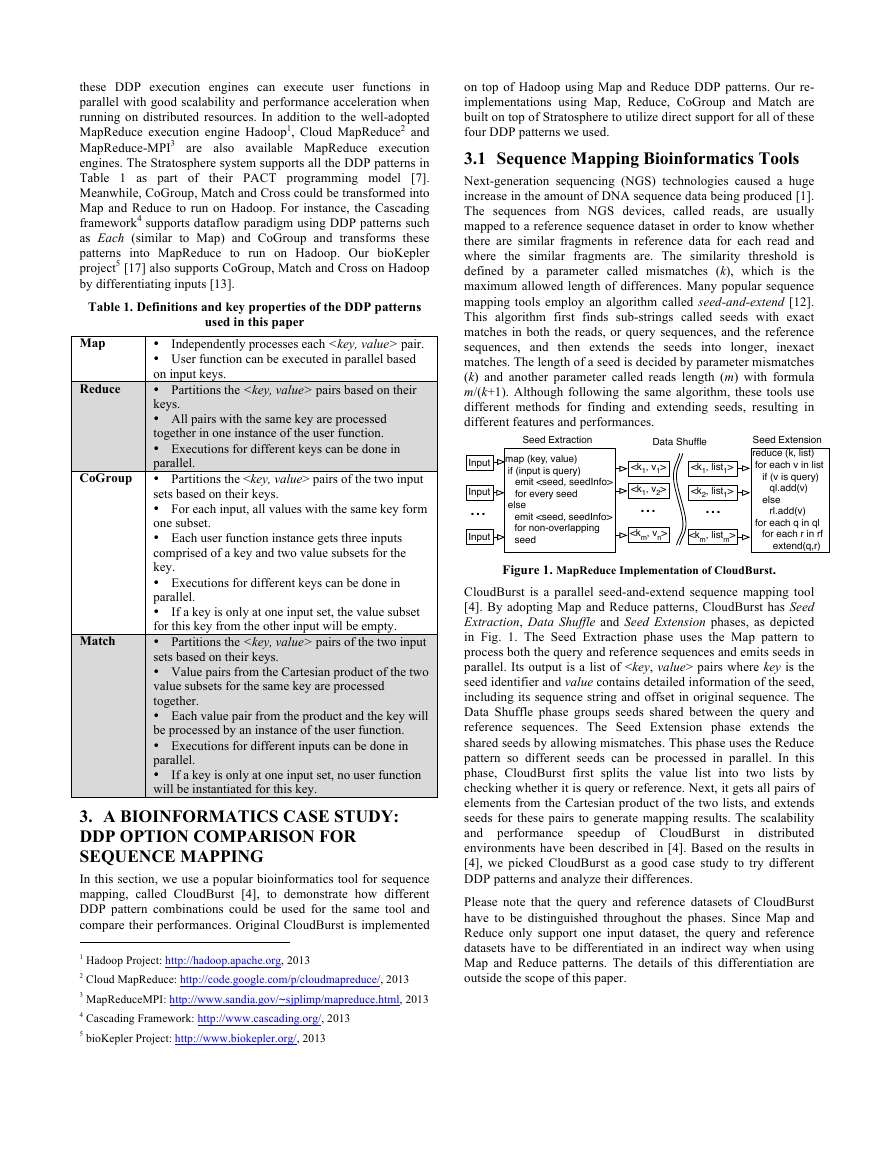
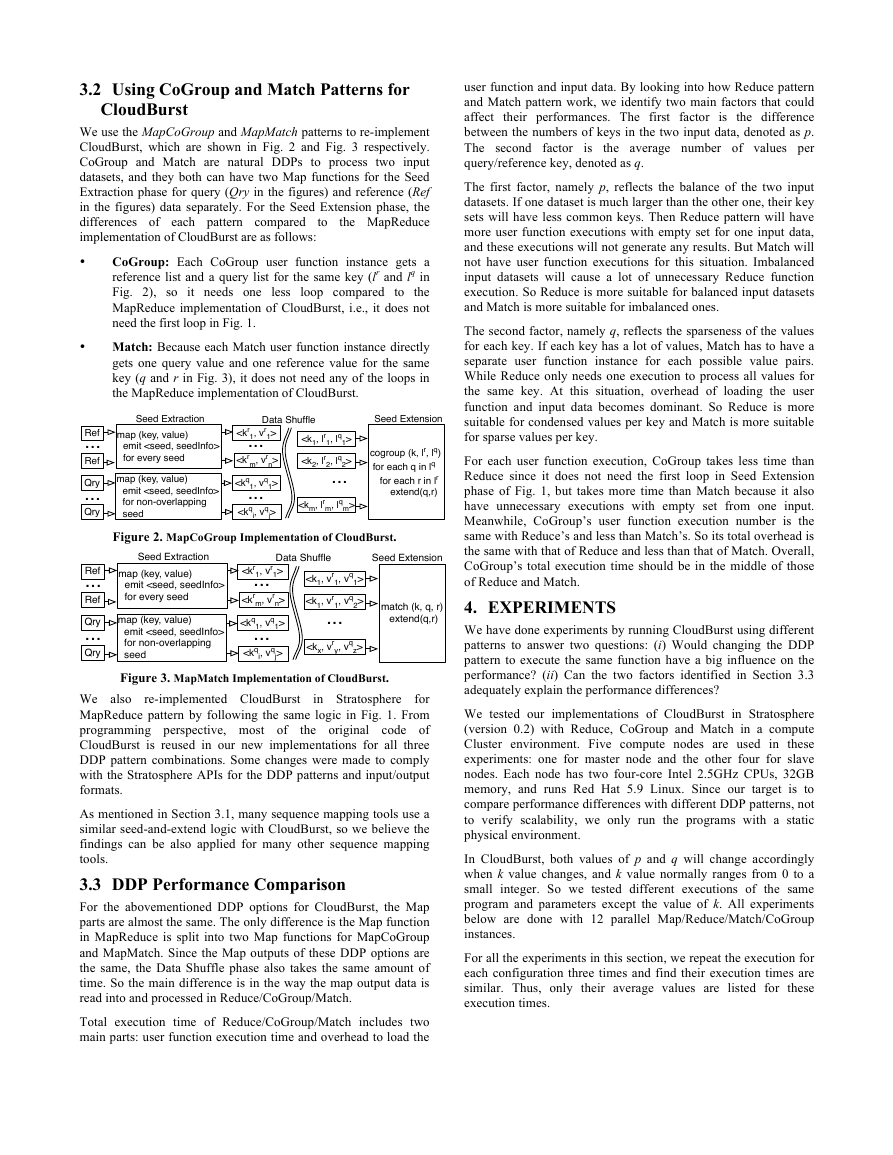
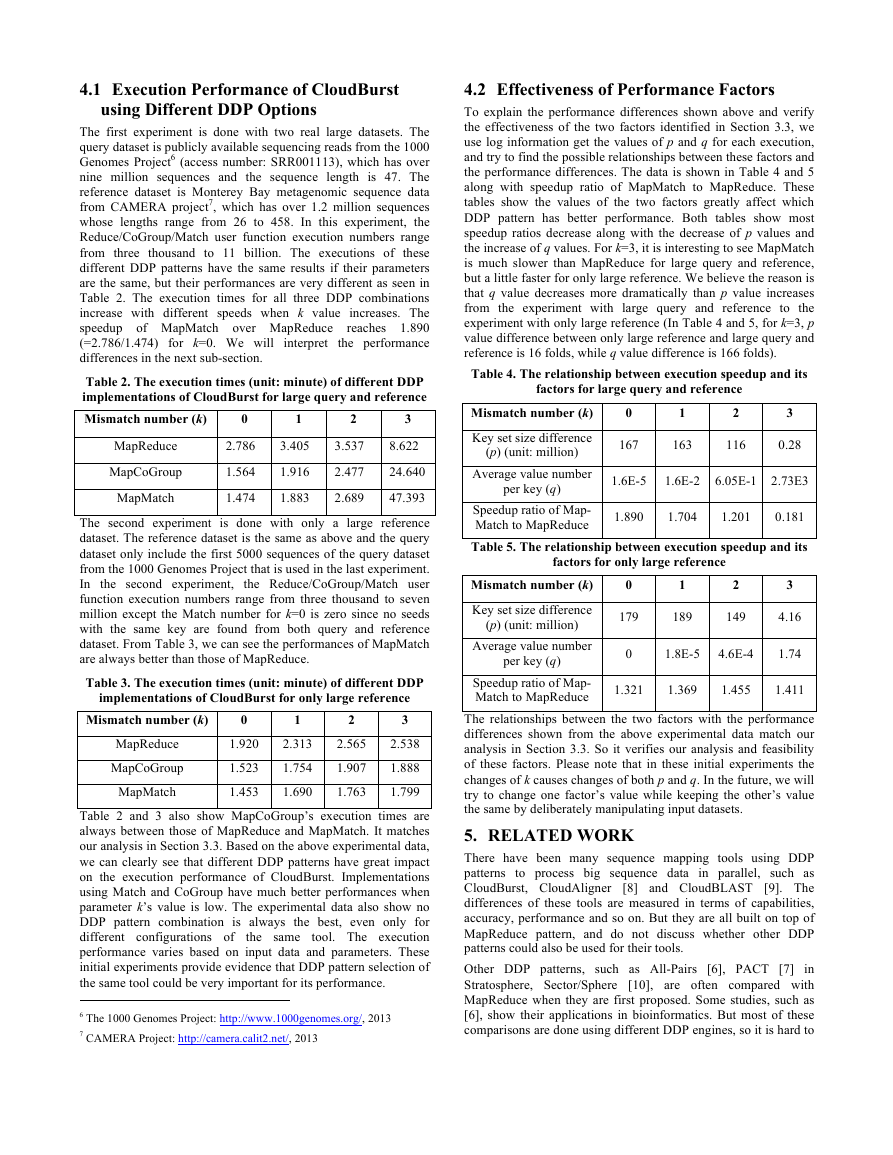
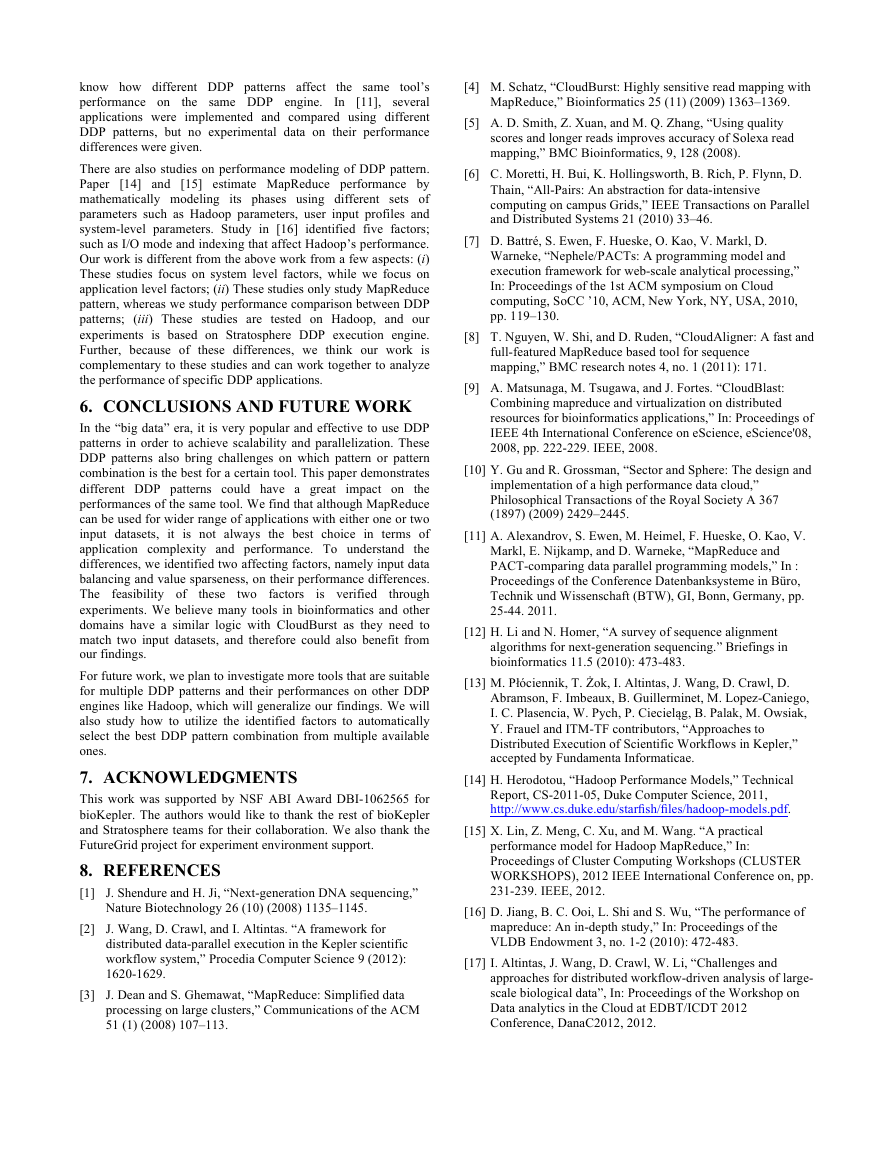





 2023年江西萍乡中考道德与法治真题及答案.doc
2023年江西萍乡中考道德与法治真题及答案.doc 2012年重庆南川中考生物真题及答案.doc
2012年重庆南川中考生物真题及答案.doc 2013年江西师范大学地理学综合及文艺理论基础考研真题.doc
2013年江西师范大学地理学综合及文艺理论基础考研真题.doc 2020年四川甘孜小升初语文真题及答案I卷.doc
2020年四川甘孜小升初语文真题及答案I卷.doc 2020年注册岩土工程师专业基础考试真题及答案.doc
2020年注册岩土工程师专业基础考试真题及答案.doc 2023-2024学年福建省厦门市九年级上学期数学月考试题及答案.doc
2023-2024学年福建省厦门市九年级上学期数学月考试题及答案.doc 2021-2022学年辽宁省沈阳市大东区九年级上学期语文期末试题及答案.doc
2021-2022学年辽宁省沈阳市大东区九年级上学期语文期末试题及答案.doc 2022-2023学年北京东城区初三第一学期物理期末试卷及答案.doc
2022-2023学年北京东城区初三第一学期物理期末试卷及答案.doc 2018上半年江西教师资格初中地理学科知识与教学能力真题及答案.doc
2018上半年江西教师资格初中地理学科知识与教学能力真题及答案.doc 2012年河北国家公务员申论考试真题及答案-省级.doc
2012年河北国家公务员申论考试真题及答案-省级.doc 2020-2021学年江苏省扬州市江都区邵樊片九年级上学期数学第一次质量检测试题及答案.doc
2020-2021学年江苏省扬州市江都区邵樊片九年级上学期数学第一次质量检测试题及答案.doc 2022下半年黑龙江教师资格证中学综合素质真题及答案.doc
2022下半年黑龙江教师资格证中学综合素质真题及答案.doc